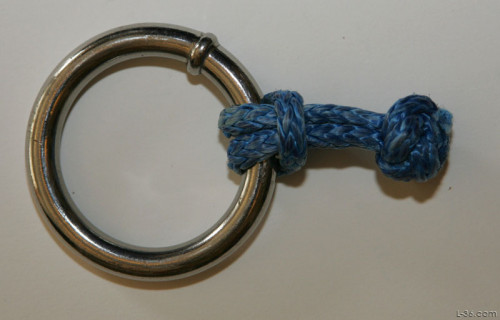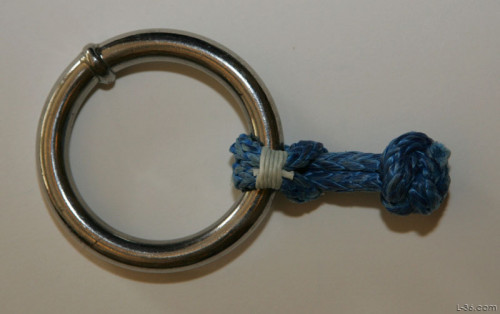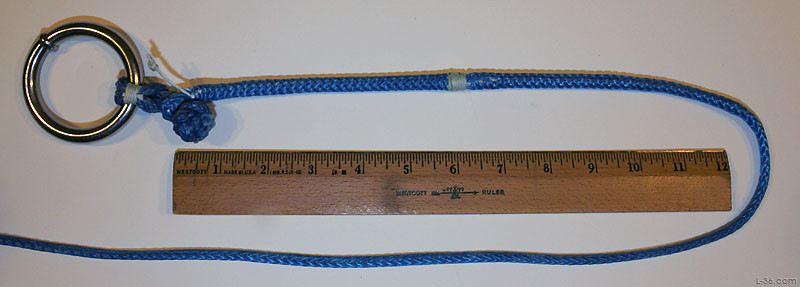Soft Halyard or Line Shackle
By Allen Edwards


Other methods I have seen for making a soft halyard shackle involve either using a soft shackle and splicing it onto the halyard, adding a knot to the halyard and integrating a soft shackle into the line, or using a pin with a retainer clip on a headsail (not shown in picture). Soft shackles are great, but they are not the easiest or quickest thing to use particularly during a sail change. The retainer clip works well on a main but not on a jib and requires something to hold it in place. Integrated halyards with knots suffer loss of strength because they are putting knots in the line which reduce the strength by more than 50%. This new method overcomes these limitations.

Above is a picture of two of the line parts of the shackle, one open and one closed . To make it, make a standard 12 strand eye splice with an eye the size of the line. I close the eye on the fid before doing the final bury. Then lock stitch half way up the splice. Pull the eye open and sew in the opening lanyard. The opening lanyard allows the shackle to be opened quickly but is optional. Don't put it too far down in the bury or the line will bunch up and prevent opening. Having the lanyard right at the top when the shackle is open is about right.

The second part is a loop with a locking stopper knot (a diamond knot). The loop goes on the halyard ring, loop, or headboard and does not come off. In use, the halyard loop is easily opened, put over the stationary loop knot, and secured by simply milking the extra loop out of the halyard. Different lengths of knot loops can be used for different applications. Note: I lock the diamond knot with considerable force using a bench vise to hold the tails and levers to pull on the loop before cutting the last inch off the tail of the knot. When the knot is set, it sounds like a rock when banged on a table. I had no slippage of the knot in my testing. Also, if for some reason you want full line strength, use the next size up line for this part. However, for many applications stretch is as important as strength and these are very strong. The stopper loop is attached to the sail using a larks head knot (luggage tag knot).


For use on a jib halyard, you would have a separate loop stopper knot for each sail and leave them in place. Optionally you can whip the stopper knot so that there is no chance it can fall off when the jib is put in storage.

This shackle design can be used for more than just halyards. Below I use it to connect a class 2 line to a class 1 line in an application where I want to be able to quickly make the connection. It basically applies anywhere you have a 12 strand line and want to attach it to something and would otherwise use a shackle soft or otherwise.

The splice in these pictures is made from 3/16 Amsteel. The bury was 12 inches long or 64 diameters. The lock stitch is at the 6 inch point. Compared to the same size 7x19 wire halyard, it is stronger and has about the same stretch. 3/16 Amsteel for use in other applications is about the same strength as 7/16 Samson XLS and has about the same stretch as 5/8 XLS.

One final note. I use a lock stitching instead of a brummel in making the soft halyard. I have made them both ways and just find the lock stitch easier. You can do the entire bury and run a needle at about half way along the bury and test the loop before settling on where to lock the stitch. Too long a loop, move the needle toward the end. Too short, move it the other way. The brummel is also more complicated if you are going to do it one ended as you end up having to run the doubled up shackle loop through the reversed hole. I will not explain it in detail for this application but the basic one end brummel is HERE. It can be done and works fine, just a bit more complicated.
References:
- Diamond Knot
- 12 strand eye splice
- Lock stitch and whipping
- How long is a fid
- Soft Shackles
- Some independent soft shackle testing (remember, the halyard splice is 1/2 as strong for the same line size)
NOTICE: Some pages have affiliate links to Amazon. As an Amazon Associate, I earn from qualifying purchases. Please read website Cookie, Privacy, and Disclamers by clicking HERE. To contact me click HERE. For my YouTube page click HERE